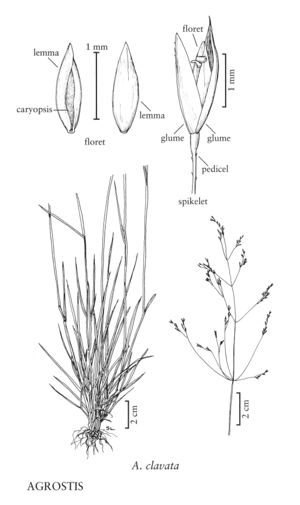Difference between revisions of "Agrostis clavata"
FNA>Volume Importer |
FNA>Volume Importer |
(No difference)
| |
Revision as of 19:17, 24 September 2019
Plants annuals or short-lived perennials; densely tufted, not rhizomatous or stoloniferous. Culms 30-70 cm, erect, smooth, with 3-6 nodes. Leaves mostly basal or basal and cauline; sheaths smooth; ligules (0.5) 1.5-4.2 mm, dorsal surfaces scabrous, apices truncate to rounded, erose-lacerate, often ciliolate; blades 10-20 cm long, 1-5(7) mm wide, flat, scabrous at least along the margins and/or veins. Panicles 8-35 cm long, 3-10 cm wide, widely ovate, becoming lax, open, usually exserted, bases sometimes enclosed in the upper sheaths at maturity, lowest node with (1)2-8 branches; branches scabrous, spreading, branched above midlength, spikelet-bearing in the distal 1/2 - 2/3, lower branches 3-12 cm; pedicels 0.5-5.5 mm, clavate; secondary panicles often present in the leaf axils, smaller than the primary panicles. Spikelets narrowly ovate to lanceolate, greenish or light brownish purple. Glumes subequal, 1.5-2.8 mm, lanceolate, 1-veined, keels somewhat aculeolate, apices usually acute, sometimes acuminate; calluses usually sparsely hairy, hairs to 0.2 mm, sometimes glabrous; lemmas 1.2-2 mm, smooth, glabrous, translucent to opaque, 5-veined, veins prominent distally or obscure, apices acute, entire, unawned; paleas absent, or to 0.2 mm and thin; anthers 3, 0.3-0.6 mm, to 1/2 as long as the lemmas. Caryopses 0.9-1.3 mm. 2n = [28], 42.
Discussion
Agrostis clavata grows in disturbed ground on sandbars and gravelbars, and in wet meadows and coniferous forests, from Sweden across northern Asia to Kamchatka. It was recently found in Alaska, the Yukon, and the Northwest Territories, and appears to be native there. It differs from the similarly large-panicled A. scabra (see next) in its much broader, flat leaves.
Selected References
None.
